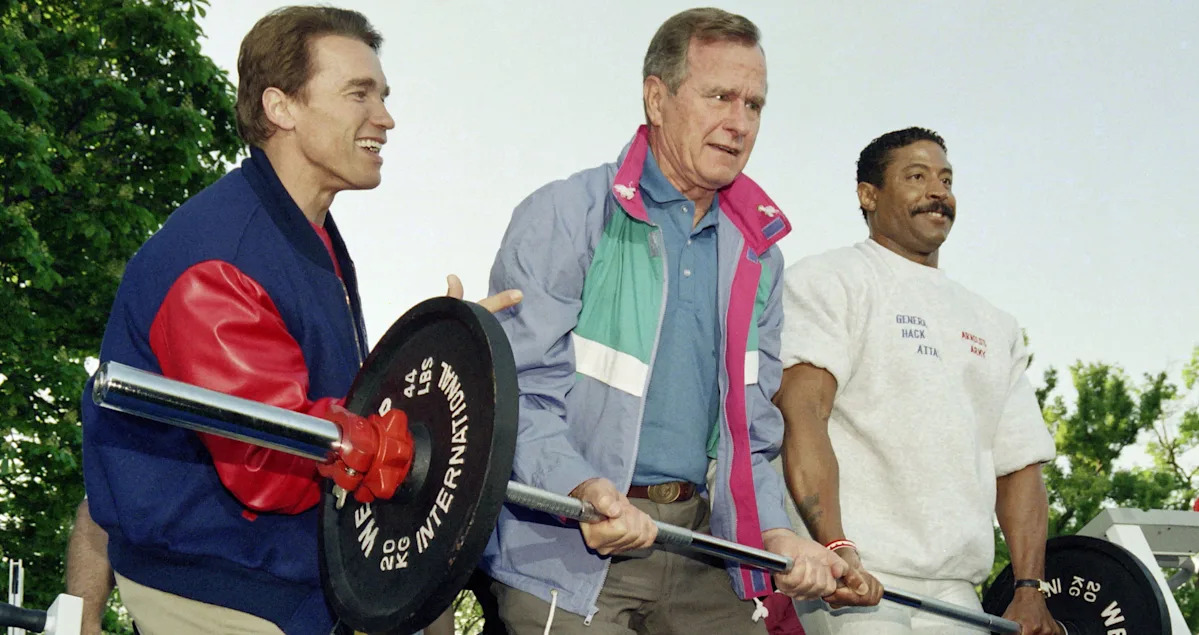President Trump signed an executive order Thursday reviving the Presidential Fitness Test, a series of physical challenges that was once something of a rite of passage for generations of American schoolchildren.
“This is a wonderful tradition, and we’re bringing it back,” Trump said during a press conference in which he was flanked by several famous athletes, including pro golfer Bryson DeChambeau and former New York Giants linebacker Lawrence Taylor.
Bringing back the test, which was scrapped by the Obama administration more than a decade ago, is part of the Trump administration’s broader campaign to “restore the urgency of improving the health of Americans,” according to the executive order.
The Presidential Fitness Test was born in the early stages of the Cold War at a time when U.S. leaders had begun to view the perceived athletic ineptitude of the average American child as a genuine national security threat.
“The harsh fact of the matter is that there is also an increasingly large number of young Americans who are neglecting their bodies — whose physical fitness is not what it should be — who are getting soft. And such softness on the part of the individual citizen can help to strip and destroy the vitality of a nation,” incoming President John F. Kennedy Jr. wrote in a 1960 magazine article titled The Soft American.
The specifics of the test changed quite a bit over the years. A softball throw that was part of the original framework — as a way to judge one’s grenade-tossing prowess — was eliminated. The sit-ups were changed from straight-leg to bent-knee posture to relieve strain on children’s backs. The runs were made longer as cardiovascular endurance became a bigger priority.
Why did the test end?
Though the test had become a routine part of the school calendar for millions of students across the country, questions about both its effectiveness and potential negative outcomes ultimately compelled the Obama administration to retire it.
For years, health experts had argued that testing kids on a limited set of specific skills is not a productive way to gauge the overall fitness of a child — let alone the general fitness of America’s youth as a whole. There were also concerns that forcing children to do these challenges in front of their peers could be a major source of shame, ridicule and bullying. In 2012, the government announced it would replace the test with the Presidential Youth Fitness Program, a more holistic health initiative that prioritized individualized goals for children over uniform, competitive testing.
Take the test yourself
The Trump administration hasn’t outlined what the exact makeup of the revived test will be, but you can measure your adult self against children of decades past by using an older version of the test. Here’s what you’ll need to do and how well you’ll need to perform to beat the average 12-year-old in 1985 or score high enough to reach the 85th percentile and earn the coveted Presidential Physical Fitness Award.
Sit-ups
What it measures: Core strength
How to do it: Lie flat on your back with knees bent and your hands on opposite shoulders. Lift your torso until your elbows touch your thighs, then lower back down until your shoulders touch the floor. Repeat as many times as possible in one minute.
50th percentile: 40 reps (boys), 35 reps (girls)
85th percentile: 50 reps (boys), 45 reps (girls)
Shuttle run
What it measures: Agility
How to do it: Mark two parallel lines 30 feet apart and place two small objects behind one of the lines. Starting at the other line, run as quickly as possible to grab one of the objects and place it on the ground back where you started. Repeat this a second time to retrieve the second object. The timer stops when you cross the starting line with the second object in your hand.
50th percentile: 10.6 seconds (boys), 11.3 seconds (girls)
85th percentile: 9.8 seconds (boys), 10.4 seconds (girls)
1-mile run
What it measures: Physical endurance
How to do it: Run, for one mile.
50th percentile: 8:40 minutes (boys), 11:05 minutes (girls)
85th percentile: 7:11 minutes (boys), 8:23 minutes (girls)
V-sit & reach
What it measures: Flexibility
How to do it: Place a measuring tape stretched out at least two feet on the floor. Sit with the soles of your feet level with the 12-inch mark of the tape measure; this is your baseline. With straight legs and knees firmly on the ground, bend forward as far as possible and hold for three seconds. Every inch beyond the baseline receives a plus value (reaching the 17-inch mark on the tape measure would be a +5 score, for example), and every inch short of the 12-inch mark gets a negative value. A version of this test can also be done with a box if one is available.
50th percentile: +1 (boys), +3.5 (girls)
85th percentile: +4 (boys), +7 (girls)
Pull-ups
What it tests: Upper body strength
How to do it: Hang from a horizontal bar with your feet off the ground. Hands can be in either an overhand or underhand position. Pull yourself up until your chin clears the bar, then lower yourself until your arms are straight for one repetition. Do as many as you can with no time limit. Swinging or kicking is not permitted, so CrossFit-style “kipping” pull-ups will not be counted.
50th percentile: 2 (boys), 1 (girls)
85th percentile: 7 (boys), 2 (girls)
